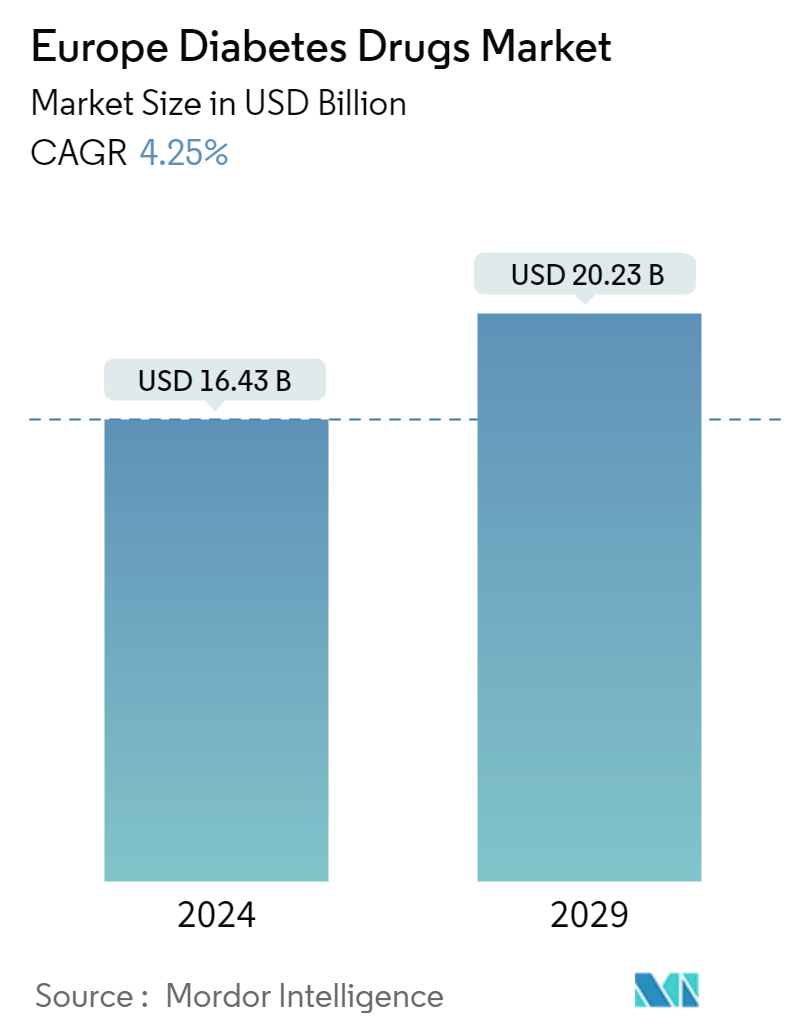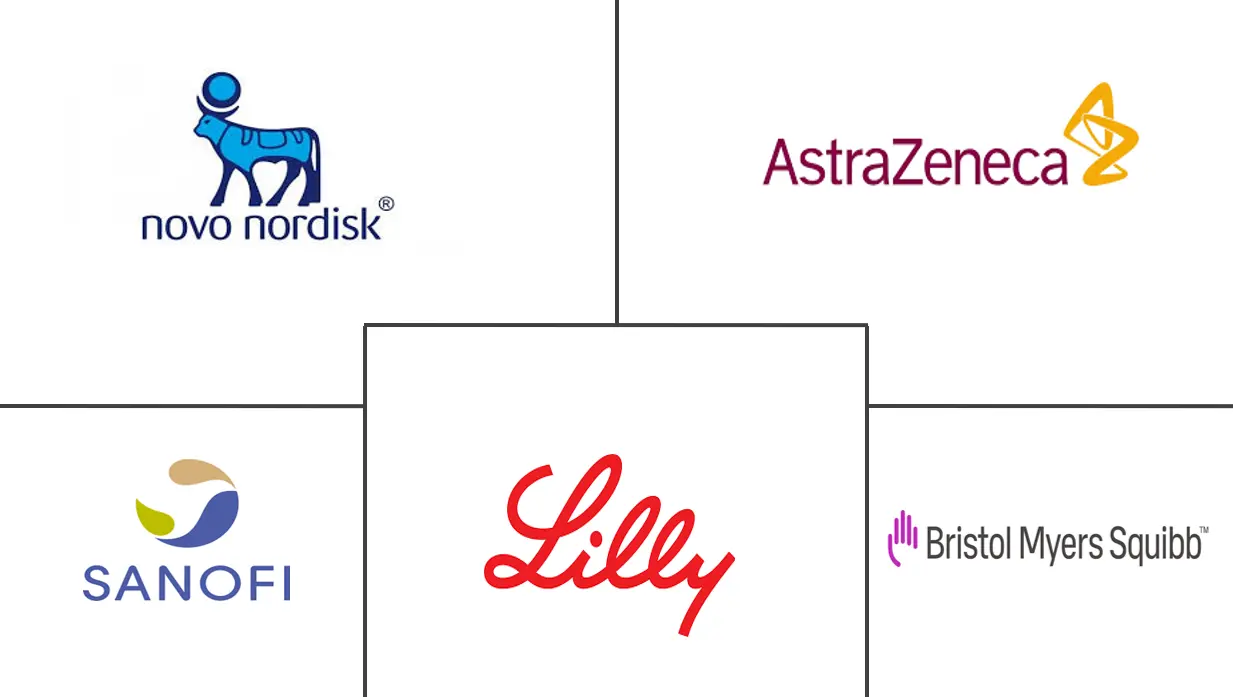Market Size of Europe Diabetes Drugs Industry

| Study Period | 2018 - 2029 |
| Base Year For Estimation | 2023 |
| Forecast Data Period | 2024 - 2029 |
| Market Size (2024) | USD 16.43 Billion |
| Market Size (2029) | USD 20.23 Billion |
| CAGR (2024 - 2029) | 4.25 % |
Major Players
*Disclaimer: Major Players sorted in no particular order |
Europe Diabetes Drugs Market Analysis
The Europe Diabetes Drugs Market size is estimated at USD 16.43 billion in 2024, and is expected to reach USD 20.23 billion by 2029, growing at a CAGR of 4.25% during the forecast period (2024-2029).
The rising number of diabetes cases in Europe is fueling growth in the European market for diabetes drugs due to several factors. Firstly, the increasing prevalence of diabetes in the region has created a larger patient pool in need of medication, leading to a higher demand for diabetes drugs. This demand is expected to continue growing as the population ages and the risk factors for diabetes, such as obesity and sedentary lifestyles, persist.
Additionally, advancements in medical technology and research have resulted in the development of more effective and innovative diabetes drugs. These new drugs offer improved glycemic control, reduced side effects, and enhanced convenience for patients, thereby driving the market growth. Pharmaceutical companies are investing heavily in research and development to bring these new drugs to the market, further stimulating the growth of the European diabetes drug market.
Moreover, governments and healthcare organizations in Europe are increasingly focusing on diabetes prevention and management programs. These initiatives aim to raise awareness about diabetes, promote healthy lifestyles, and ensure access to affordable and effective diabetes drugs. As a result, there is a growing emphasis on early diagnosis and treatment, leading to an increased demand for diabetes drugs.
Furthermore, the European market for diabetes drugs is witnessing a surge in mergers, acquisitions, and collaborations among pharmaceutical companies. These strategic partnerships allow companies to combine their resources, expertise, and product portfolios to better address the growing demand for diabetes drugs. Such collaborations also enable companies to expand their geographical reach and tap into new markets, further driving the market growth.
In conclusion, the rising number of diabetes cases in Europe is fueling growth in the European market for diabetes drugs. Factors such as the increasing prevalence of diabetes, advancements in medical technology, government initiatives, and strategic collaborations among pharmaceutical companies are all contributing to the expansion of this market. As the demand for diabetes drugs continues to rise, the market is expected to witness further growth in the coming year.
Europe Diabetes Drugs Industry Segmentation
Diabetes Drugs are used to treat diabetes mellitus by lowering the glucose level in the blood. The Europe Diabetes Drugs Market is segmented into drugs and geography. The report offers the value (in USD) for the above segments
| Insulins | |||||||
| |||||||
| |||||||
| |||||||
|
| Oral Anti-diabetic drugs | ||||||
| ||||||
| ||||||
| ||||||
| ||||||
| ||||||
| ||||||
|
| Non-Insulin Injectable drugs | |||||||
| |||||||
|
| Combination drugs | |||||
| |||||
|
| Geography | |
| United Kingdom | |
| Germany | |
| Italy | |
| Spain | |
| France | |
| Russia | |
| Rest of Europe |
Europe Diabetes Drugs Market Size Summary
The European diabetes drugs market is experiencing significant growth, driven by the increasing prevalence of diabetes across the region. This rise in diabetes cases has created a substantial patient pool requiring medication, thereby boosting the demand for diabetes drugs. The market is further propelled by advancements in medical technology and research, leading to the development of more effective and innovative drugs that offer improved glycemic control and reduced side effects. Pharmaceutical companies are heavily investing in research and development to introduce these new drugs, which is contributing to the market's expansion. Additionally, government and healthcare organizations in Europe are focusing on diabetes prevention and management programs, which emphasize early diagnosis and treatment, further increasing the demand for diabetes drugs.
The market is characterized by strategic collaborations, mergers, and acquisitions among pharmaceutical companies, enabling them to combine resources and expertise to meet the growing demand for diabetes drugs. These partnerships also facilitate the expansion of geographical reach and entry into new markets. Germany is expected to dominate the market, with a significant number of diabetes cases and a focus on high-quality care and self-management. The introduction of new drug classes, such as DPP-4 and SGLT-2 inhibitors, has also contributed to market growth. The European diabetes drugs market is fragmented, with major manufacturers like Eli Lilly, Sanofi, Novo Nordisk, and AstraZeneca holding significant market shares. These companies are engaged in strategy-based operations to maintain competitiveness and explore new revenue streams.
Europe Diabetes Drugs Market Size - Table of Contents
-
1. MARKET DYNAMICS
-
1.1 Market Overview
-
1.2 Market Drivers
-
1.3 Market Restraints
-
1.4 Porter's Five Forces Analysis
-
1.4.1 Bargaining Power of Suppliers
-
1.4.2 Bargaining Power of Consumers
-
1.4.3 Threat of New Entrants
-
1.4.4 Threat of Substitute Products and Services
-
1.4.5 Intensity of Competitive Rivalry
-
-
-
2. MARKET SEGMENTATION
-
2.1 Insulins
-
2.1.1 Basal or Long Acting Insulins
-
2.1.1.1 Lantus (Insulin Glargine)
-
2.1.1.2 Levemir (Insulin Detemir)
-
2.1.1.3 Toujeo (Insulin Glargine)
-
2.1.1.4 Tresiba (Insulin Degludec)
-
2.1.1.5 Basaglar (Insulin Glargine)
-
-
2.1.2 Bolus or Fast Acting Insulins
-
2.1.2.1 NovoRapid/Novolog (Insulin Aspart)
-
2.1.2.2 Humalog (Insulin Lispro)
-
2.1.2.3 Apidra (Insulin Glulisine)
-
-
2.1.3 Traditional Human Insulins
-
2.1.3.1 Novolin/Actrapid/Insulatard
-
2.1.3.2 Humulin
-
2.1.3.3 Insuman
-
-
2.1.4 Biosimilar Insulins
-
2.1.4.1 Insulin Glargine Biosimilars
-
2.1.4.2 Human Insulin Biosimilars
-
-
-
2.2 Oral Anti-diabetic drugs
-
2.2.1 Biguanides
-
2.2.1.1 Metformin
-
-
2.2.2 Alpha-Glucosidase Inhibitors
-
2.2.2.1 Alpha-Glucosidase Inhibitors
-
-
2.2.3 Dopamine D2 receptor agonist
-
2.2.3.1 Bromocriptin
-
-
2.2.4 SGLT-2 inhibitors
-
2.2.4.1 Invokana (Canagliflozin)
-
2.2.4.2 Jardiance (Empagliflozin)
-
2.2.4.3 Farxiga/Forxiga (Dapagliflozin)
-
2.2.4.4 Suglat (Ipragliflozin)
-
-
2.2.5 DPP-4 inhibitors
-
2.2.5.1 Onglyza (Saxagliptin)
-
2.2.5.2 Tradjenta (Linagliptin)
-
2.2.5.3 Vipidia/Nesina(Alogliptin)
-
2.2.5.4 Galvus (Vildagliptin)
-
-
2.2.6 Sulfonylureas
-
2.2.6.1 Sulfonylureas
-
-
2.2.7 Meglitinides
-
2.2.7.1 Meglitinides
-
-
-
2.3 Non-Insulin Injectable drugs
-
2.3.1 GLP-1 receptor agonists
-
2.3.1.1 Victoza (Liraglutide)
-
2.3.1.2 Byetta (Exenatide)
-
2.3.1.3 Bydureon (Exenatide)
-
2.3.1.4 Trulicity (Dulaglutide)
-
2.3.1.5 Lyxumia (Lixisenatide)
-
-
2.3.2 Amylin Analogue
-
2.3.2.1 Symlin (Pramlintide)
-
-
-
2.4 Combination drugs
-
2.4.1 Insulin combinations
-
2.4.1.1 NovoMix (Biphasic Insulin Aspart)
-
2.4.1.2 Ryzodeg (Insulin Degludec and Insulin Aspart)
-
2.4.1.3 Xultophy (Insulin Degludec and Liraglutide)
-
-
2.4.2 Oral Combinations
-
2.4.2.1 Janumet (Sitagliptin and Metformin)
-
-
-
2.5 Geography
-
2.5.1 United Kingdom
-
2.5.2 Germany
-
2.5.3 Italy
-
2.5.4 Spain
-
2.5.5 France
-
2.5.6 Russia
-
2.5.7 Rest of Europe
-
-
Europe Diabetes Drugs Market Size FAQs
How big is the Europe Diabetes Drugs Market?
The Europe Diabetes Drugs Market size is expected to reach USD 16.43 billion in 2024 and grow at a CAGR of 4.25% to reach USD 20.23 billion by 2029.
What is the current Europe Diabetes Drugs Market size?
In 2024, the Europe Diabetes Drugs Market size is expected to reach USD 16.43 billion.

